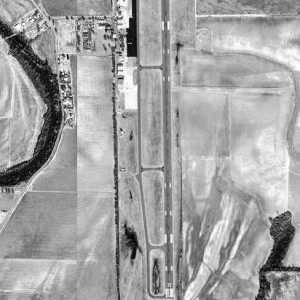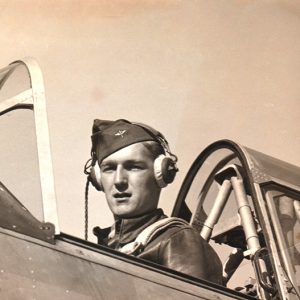calsfoundation@cals.org
Grider Army Air Field
Grider Army Air Field was a World War II Army Air Corps training facility located in Jefferson County. Named posthumously in honor of World War I pilot John McGavock Grider of Osceola (Mississippi County), it opened on March 22, 1941. Today, the field survives as southeast Arkansas’s first modern municipal airport, encompassing 850 acres. It is located nearly six miles southeast of Pine Bluff (Jefferson County), off Highway 65 South and north of U.S. Highway 425.
Construction on the airfield was set in motion in late November 1940, as voters had approved a $200,000 bond issue and city officials garnered a $107,320 grant from President Franklin D. Roosevelt’s Depression-era Works Progress Administration (WPA). Several factors led to the genesis of southeast Arkansas’s first modern airfield. The Civil Aviation Authority had earlier adopted stricter regulations for airfields in order to accommodate the aircraft industry’s constantly evolving development of larger and faster aircraft—thus making Pine Bluff’s first airfield, Toney Field, obsolete.
With war raging across Europe and Japanese militarism rising in the Pacific, community leader, pilot, and member of the National Aeronautical Association Felix G. Smart was aware of Army Air Corps commander Henry Harley “Hap” Arnold’s attempts to arrange contracts with private flying schools to conduct primary flight training for the fledgling Army Air Corps pilots. Smart contacted Arnold’s headquarters. In December 1940, Brigadier General Gerald C. Brant, commanding officer of the Army Air Corps training facility at Randolph Field, Texas, arrived in Jefferson County with a small staff to inspect the site for a new military Army Air Corps training facility.
In just over four months, a cotton field was leveled, surveyed, and sodded for an airfield. Administrative buildings, aircraft hangars, barracks, a mess hall, and a control tower were erected, and concrete aprons were poured to divert water from specific buildings and hangars. Grider Field eventually encompassed a total of fourteen buildings on a fifteen-acre tract; up to 150 cadets could be housed and trained there. Six Fairchild PT-19—single prop, two-seated aircraft—were flown from Hagerstown, Maryland, to be used at Grider Field for the beginning flight training. On March 22, 1941, under control of the United States Army Air Corps, Grider Field received its first class of fifty cadets scheduled for ten weeks of flight instruction. The field was formally dedicated on May 24, 1941.
The Army Air Corps training school at the airfield was in operation for three and a half years, admitted around 12,000 pilot trainees, and graduated approximately 9,000 pilots. A former instructor at the Air Corps School, Willard Haralson, recalled that two instructors, one civilian, and five cadet pilots were killed in training exercises at the airfield during its operation. At one time, 275 aircraft were being used to train 758 prospective pilots.
After the war, the airfield was returned to the City of Pine Bluff by the Civilian Aeronautics Authority (CAA) in 1947, and the city maintained the airfield until 1957. Thereafter, the Pine Bluff Aviation Commission was established to manage and maintain the airfield as a general aviation airport for southeast Arkansas. Today, Grider Field is an 850-acre airport facility with a small terminal, restaurant, Federal Aviation Administration (FAA) weather monitoring station, private corporate jet hangars, fire station, aircraft rental hangars, a flight museum, and a host of on-site operators offering fuel and avionics services for southeast Arkansas. The airport is operated by a full-time, on-site airport manager and a six-member volunteer commission. Corporate users of the airport include Tyson Foods, Jefferson Regional Medical Facility, International Paper Company, the Pine Bluff Arsenal, the Arkansas Department of Correction, and the Union Pacific Railroad. The Jacksonville Air Force Base uses the runway, though rarely, for C-130 aircraft training, and the FAA has trained some pilots at the airport. The airport is a department of the City of Pine Bluff, and airport funding is derived from fuel sales, user leases, andgeneral appropriations from the city.
As of 2020, four of the five original round-topped hangers and one of the original barracks for pilot trainees still stand.
For additional information:
Colvin,Eplunus. “Grider Field Airport to Undergo Renovations.” Pine Bluff Commercial, October 22, 2021, pp. 1, 2. Online at https://www.arkansasonline.com/news/2021/oct/22/grider-field-airport-undergo-renovations/ (accessed April 6, 2022).
Ellis, Dale. “After Decades, Taxiway at Grider Field Due to Get Straightened Out.” Pine Bluff Commercial, September 20, 2020, pp. 1. 2. https://www.nwaonline.com/news/2020/sep/20/after-decades-taxiway-at-grider-field-due-to-get/ (accessed April 6, 2022).
———. “Old Airfield Had a Vital Role in WWII.” Pine Bluff Commercial, September 20, 2020, p. 2.
Leslie, James W. “At 50th Reunion Celebration: Memories of Grider Field Will be Swapped.” Pine Bluff News, May 2, 1991, p. 4B.
———. “Old Stories Should Soar at Grider Field Reunion.” Pine Bluff Commercial, August 15, 1982, p. 13.
Powell, Richard Stephen. “Air Crashes at Grider Field.” Jefferson County Historical Quarterly 48 (Summer 2020): 5–13.
Ward, Helene I. “Grider Field is Dedicated in Pine Bluff.” Arkansas Democrat, May 25, 1941, pp. 1–2.
Russell E. Bearden
White Hall, Arkansas
 World War II
World War II World War II through the Faubus Era, 1941 through 1967
World War II through the Faubus Era, 1941 through 1967 Grider Army Air Field
Grider Army Air Field  Grider Field
Grider Field  James Waldron
James Waldron  James Waldron Certificate
James Waldron Certificate 



Comments
No comments on this entry yet.